#daughter of king henry viii and anne boleyn
Explore tagged Tumblr posts
Text


THE KING'S SISTERS
Margaret and Mary, Princesses of England, were daughters of Henry VII, King of England, and Elizabeth of York, Queen of England, making them the sisters of Arthur Prince of Wales and Henry VIII, King of England. Margaret became the Queen Consort of Scotland by her first marriage to James IV of Scotland, becoming Dowager Queen of Scotland after his death and at times Queen Regent of Scotland on behalf of their son James V, King of Scotland their only child to reach adulthood. On the occasion of her second marriage to Archibald Douglas, Earl of Angus she became the Countess of Angus, they had one child Margaret Douglas who grew up in the court of her brother, Margaret's marriage to Angus ended in divorce which Margaret instigated and successfully obtained at the astonishment of courts abroad including her own brothers. By her third marriage to Henry Stewart, Lord Methven she became Lady Methven no issue came of this union. Through her son, she became the grandmother of Mary I, Queen of Scotland commonly known as Mary, Queen of Scots who was later executed by her niece Elizabeth I of England. Through her daughter, she was the grandmother of Henry Stuart, Lord Darnley and Charles Stuart, Earl of Lennox. She was the great-grandmother twice over of James VI of Scotland and I of England making her the ancestress of all monarchs of England and then Great Britain. Mary became the Queen Consort of France by her first marriage to Louis XII of France, their marriage only lasted two months and three weeks (shorter than any of her brothers' marriages) with the sudden death of her husband, she then became Dowager Queen of France no issue came from this union. Her second marriage was to Charles Brandon, Duke of Suffolk making her the Duchess of Suffolk, their marriage caused quite a stir as Henry wanted to arrange another marriage of alliance for her and Henry's court did not want to grant more power to her husband. They later married a second time in the presence of her brother once welcomed back in her brother's court. They were married for eighteen years and she often took her husband's side on major issues of Henry's reign including being outspoken against his want and later marriage to Anne Boleyn, as well as Anne's character and actions. Her marriage to Charles produced four children with two daughters reaching adulthood Frances and Eleanor. Per the Act of Succession 1536 (three years after her death), her heirs took precedence over her elder sisters and were next in line to the English throne after her brothers. Through Frances Mary was the grandmother of Jane Grey, Queen Regnant of England who was made the heir of Edward VI over his sisters, Jane was later executed by Mary's niece Mary I of England. Mary's other Grey granddaughters Catherine and Mary also were points of contention during Elizabeth I's reign.
[As portrayed by Georgie Henley and Sai Bennett in Starz The Spanish Princess]
#the spanish princess#thespanishprincessedit#perioddramaedit#georgie henley#sai bennett#margaret tudor#mary rose tudor#mary tudor#my edits
25 notes
·
View notes
Text




Final Scene in Blood, Sex and Royalty. About Anne Boleyn's daughter with King Henry the Eighth. - Queen Elizabeth the First.
#the tudor dynasty#the tudors#tudor period#tudors#queen elizabeth i of england#queen elizabeth tudor#queen elizabeth the virgin queen#the virgin queen#queen elizabeth I#daughter of anne boleyn#daughter of king henry Vii#rule breaker#daughter of king henry viii and anne boleyn
56 notes
·
View notes
Note
Hello, can you do a headcannon Yandere (father) King Henry and Yandere (mother) Anna Boleyn with their only surviving son?
❝ 👑 — lady l: I really like the idea of them being platonic yanderes for a son, so I hope you like it! Forgive me for any mistakes and good reading! ❤️
❝tw: obsessive and possessive behavior, overprotection, mention of miscarriages, murder and implied cheating and toxic relationships.
❝👑pairing: platonic yandere!henry viii/anne boleyn x son!reader.
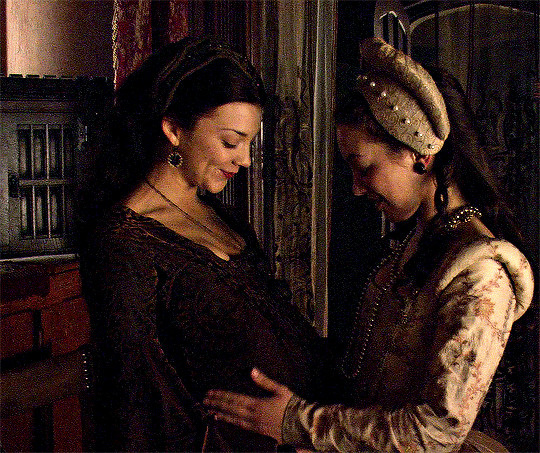

Anne was desperate to conceive a male heir, her only hope of staying alive and maintaining the interest of the King who, after some miscarriages and the birth of a daughter, has already began to wander towards one of her ladies-in-waiting.
So when she discovered a new pregnancy, she desperately prayed for a son and that she wouldn't suffer another miscarriage. She could not bear the loss and pain. Henry was pleased with the new pregnancy, but worried. Anne had already had several miscarriages and was only able to produce one healthy child, a daughter.
Anne took great care of herself during her pregnancy, taking care of what she ate and drank and trying to maintain good health. The first few months were the most tense, with fear enveloping both Anne and Henry. As the pregnancy progressed and there was no miscarriage, Anne became more confident.
When the day finally arrived to give birth, she was anxious. Henry was also anxious and he was so nervous when he heard Anne screaming outside the room, he didn't know what to think. When a baby's cries finally came after what seemed like hours, he entered the room.
Anne held her baby on her lap and cried softly and when a doctor approached Henry and said, "Congratulations, Your Majesty. You have an heir", it was the first time that Henry felt complete happiness. When he picked you up, he was smiling from ear to ear. Not only were you the much-desired male heir but you also saved your mother's head.
Both of them would be extremely overprotective of their only son and those close to you will be scrutinized. Henry has become very paranoid about your safety and takes every precaution possible.
You are always by your mother or father's side, you cannot be alone at any time with a stranger. Anne, especially, would like to keep you sewn to her side all the time. She cares about you a lot and is always checking up on you. When you get sick, she becomes paranoid that you will die.
You are your parents' greatest pride and Henry doesn't try to hide it. He neglects all his other children and gives you all his love and affection. He takes you for walks, hunting and spoils you with all the perks that a future King deserves. In addition to showing you off before the Court. After all, you are the future King.
They are both very proud of anything you do. Any milestone, no matter how small, will be applauded by them. Your first words, the first time you walked and everything else will be treated with great celebration. Expensive parties are thrown in your honor all the time.
As you grow up, they become even more overprotective and controlling. Anne does not want you to leave the Court under any circumstances and Henry allows you to do so, but only with many guards. There were many threats lurking and they couldn't let anything happen to you. May God forbid anything from happening to you as the results will be disastrous.
Anne hates it when you spend time with other people, especially if they are women. The only women you need in your life are your mother and your older sister, Elizabeth. Although she understands that's a part of a man's life, she still doesn't like it and any potential mistress or love interest will be dealt with quickly. She is your mother, so no one has more right to you than her.
Henry is more than aware of his wife's actions and although he doesn't encourage them, he doesn't reprimand her. In fact, he's probably the one who encourages you to enjoy your life even if it always leads to fights with Anne. It was worth it when you looked happy. And your happiness is very important to him.
Your potential friends will be scrutinized and if your parents don't like them, they will leave. Henry and Anne won't sentence them to death at first, but if you or they are stubborn, they will be tried for treason. Don't you understand that you shouldn't trust anyone other than your own family? Your parents are the only ones who want the best for you.
Henry and Anne are smothering and protective parents but they only have your best interests at heart. They want you to live a full and happy life, but with them by your side. You were everything they both wanted and they would be damned if they let anything happen to you. England still does not know the fury of its monarchs nor the overwhelming love they feel for their only son.
#yandere history#history#the tudors#yandere historical characters#yandere the tudors#yandere henry viii#yandere anne boleyn#Platonic yandere henry viii#platonic yandere anne boleyn#x male reader#headcanons#yandere headcanons#henry viii#anne boleyn#platonic yandere
696 notes
·
View notes
Text


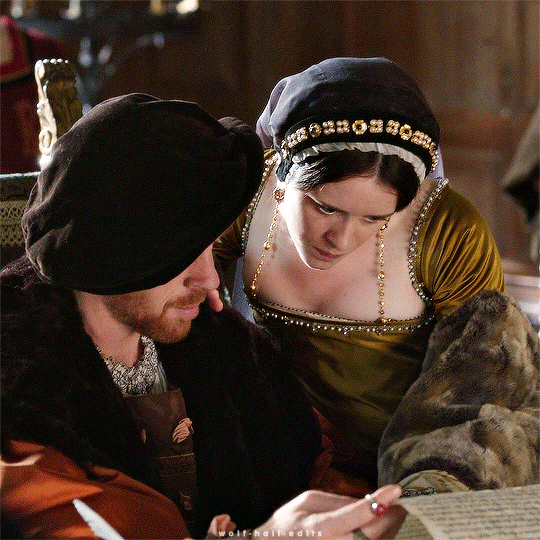
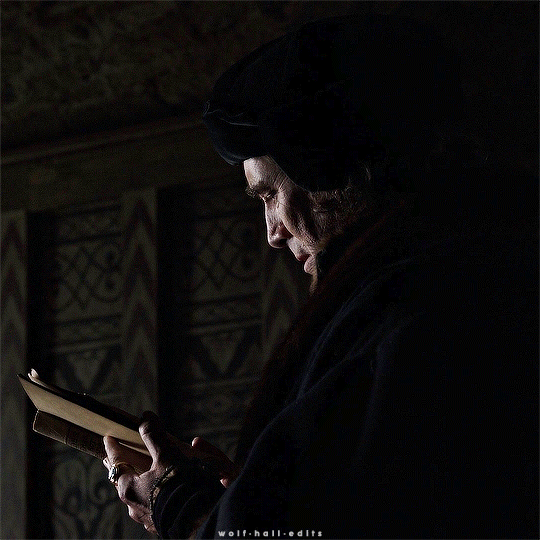

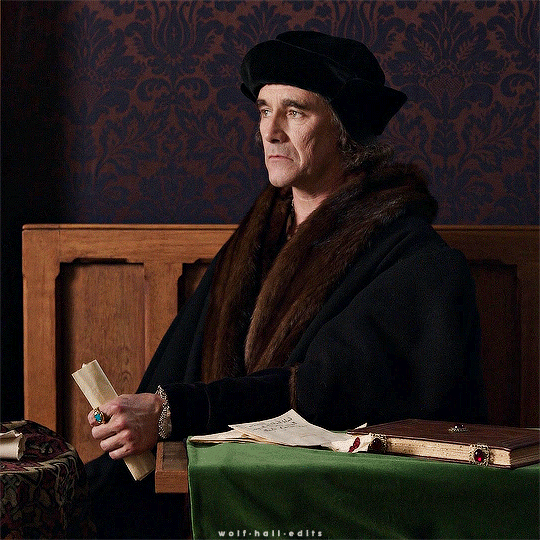



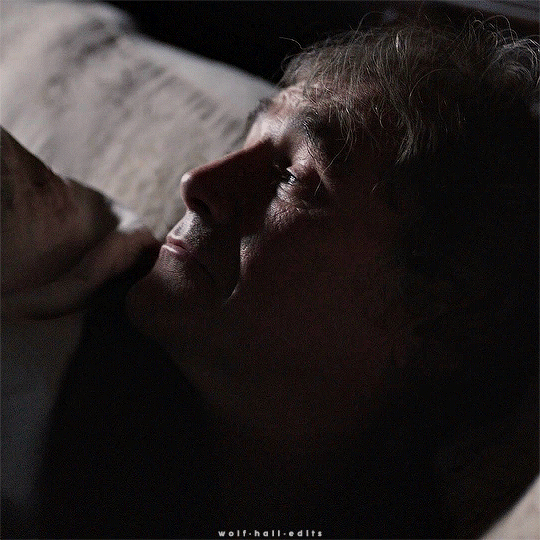
'WOLF HALL' RECAP — 1x04 'The Devil's Spit' air date — 11 February 2015 dir. Peter Kosminsky
In 1533, Anne Boleyn has given birth to a daughter, much to King Henry VIII's disdain. As Anne's paranoia over her inability to produce a son grows, Thomas Cromwell tries to convince Sir Thomas More to show approval for the royal marriage.
#wolf hall#wolhhalledit#thomas cromwell#mark rylance#hilary#hilary mantel#period drama#anne boleyn#thomas more#jane seymour#henry viii#welo#weloveperioddrama#onlyperioddramas#tudorerasource#16th cen#16th century#mediagifs#byfefa#ours#gif#1x04#the devil's spit#season 1#s1
207 notes
·
View notes
Text

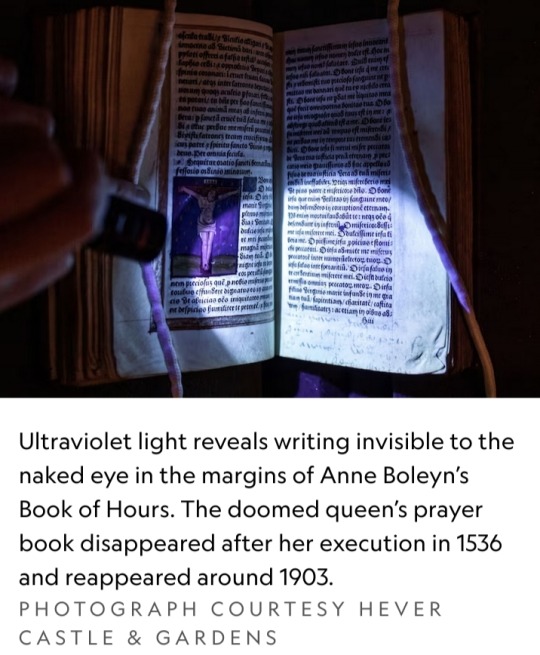
By Leslie Patrick
1 August 2023
Anne Boleyn (c. 1501 or 1507 – 19 May 1536), King Henry VIII's second queen, is often portrayed as a seductress and ultimately the woman responsible for changing the face of religion in England.
In reality, she was a fiercely intelligent and pious woman dedicated to education and religious reform.
But after her arrest and execution on false charges of adultery and incest in May 1536, Henry VIII was determined to forget her memory.
Her royal emblems were removed from palace walls, her sparkling jewels tucked away in dark coffers, and her precious books disappeared from the pages of time.
One of Boleyn’s books that has reappeared is the Book of Hours, a stunning prayer book, printed around 1527 with devotional texts designed to be read throughout the day, features hand-painted woodcuts — as well as a rare example of the queen’s own writing.
In the margins of one of the beautifully decorated pages, she penned a rhyming couplet followed by her signature:
“Remember me when you do pray, that hope doth lead from day to day, Anne Boleyn.”
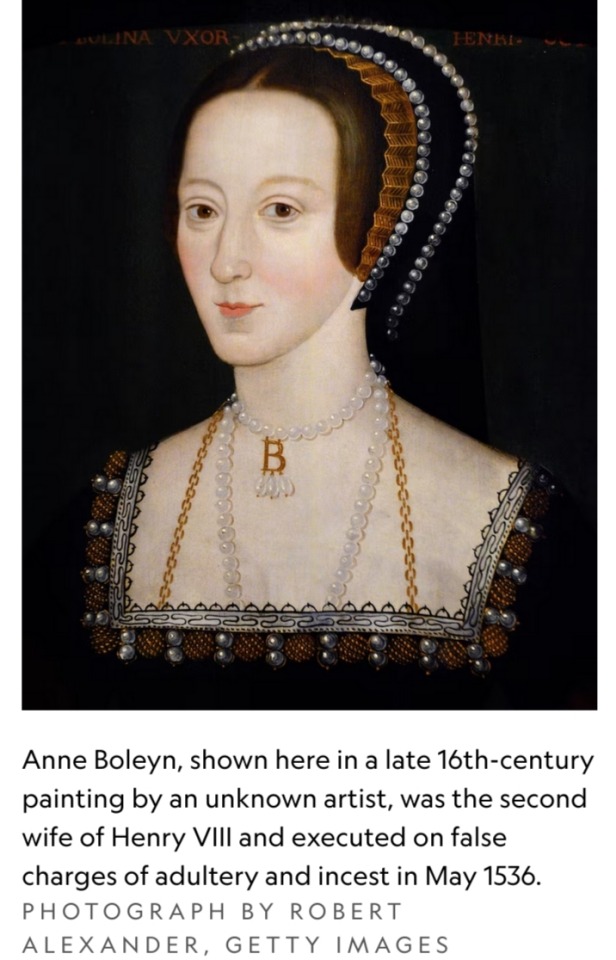
The book vanished with Boleyn’s execution in 1536, then resurfaced around 1903 when it was acquired by the American millionaire William Waldorf Astor (31 March 1848 – 18 October 1919) after he purchased Hever Castle, Anne Boleyn’s childhood home in the English countryside.
The hiding place of the disgraced queen’s devotional tome had been a mystery for centuries, until recent research by a university student uncovered hidden signatures that helped trace its path through history.
The discovery
The book’s whereabouts in the 367 years between Boleyn’s death and its reemergence remained puzzling until 2020 when Kate McCaffrey, then a graduate student at the University of Kent working on her master’s thesis about Anne Boleyn’s Book of Hours, found something unexpected in the margins of the book.
“I noticed what appeared to be smudges to the naked eye,” recalls McCaffrey, assistant curator at Hever Castle since 2021.
Intrigued, she borrowed an industrial-strength ultraviolet light and set it up in the darkest room of Hever Castle.
Ultraviolet light is often used to examine historical documents because ink absorbs the ultraviolet wavelength, causing it to appear darker against the page when exposed.
“The words just came through. It was incredible to see them underneath the light, they were completely illuminated,” the curator recalls.
McCaffrey’s theory is that the words were erased during the late Victorian era when it was popular to cleanse marginalia from books or manuscripts.
But thanks to her extraordinary detective work, these erased words turned out to be the key that unlocked the tale of the book’s secret journey from certain destruction at the royal court to safety in the hands of a dedicated group of Boleyn’s supporters.
The guardians
Indeed, various pages throughout the text reveal the names and notations of a string of Kentish women — Elizabeth Hill, Elizabeth Shirley, Mary Cheke, Philippa Gage, and Mary West — who banded together to safeguard Anne's precious book and keep her memory alive.
While it’s unclear how the book was initially passed to these women, Anne Boleyn expert Natalie Grueninger suggests it was gifted by Anne to a woman named Elizabeth Hill.
Elizabeth grew up near Hever Castle, and her husband, Richard Hill, was sergeant of the King’s Cellar at Henry VIII’s court.
There are records of the Hill’s playing cards with the king, and there may have been a friendship between Elizabeth and the queen that prompted Boleyn to pass her prayer book on before her execution.
“This extended Kentish family kept the book safe following Anne’s demise, which was an incredibly brave and bold act considering it could have been considered treasonous,” says Grueninger, podcaster and author of the book The Final Year of Anne Boleyn.
Anne’s Book of Hours was passed between mothers, daughters, sisters, and nieces until the late sixteenth century, when the last name makes its appearance in its margins.
“This story is an example of the women in the family prioritizing loyalty, friendship, fidelity, and a personal connection to Anne,” says McCaffrey.
“The fact that the women have kept it safe is a really beautiful story of solidarity, community, and bravery.”
The book, currently on display at Hever Castle, is a touchstone of the enigma that was Anne Boleyn.
Castle historian and assistant curator Owen Emmerson points out that the book contains Anne’s DNA on the pages from where she touched and kissed it during her daily devotions.
“This was a really beloved possession of hers,” says Emmerson.
“Because of what happened to Anne Boleyn, we don’t have a vast amount of information in Anne’s own words. But the physical remnants of her use of the book, and the construction of that beautiful little couplet, have her identity in them.”
While Anne’s Book of Hours has finally found its way home, the research into this intriguing historical mystery is not yet over.
McCaffrey continues to chart the book’s provenance through the centuries to find out where it was hiding all this time.
The discovery of the inscriptions illuminates the book’s furtive journey, providing us with a glimpse into the controversy, loyalty, and fascination that Anne Boleyn has engendered for the past 500 years.

#Anne Boleyn#King Henry VIII#Book of Hours#William Waldorf Astor#Hever Castle#Kate McCaffrey#University of Kent#ultraviolet light#Natalie Grueninger#Owen Emmerson#Elizabeth Hill#Elizabeth Shirley#Mary Cheke#Philippa Gage#Mary West#The Tudors#House of Tudor#British Royal Family
567 notes
·
View notes
Text
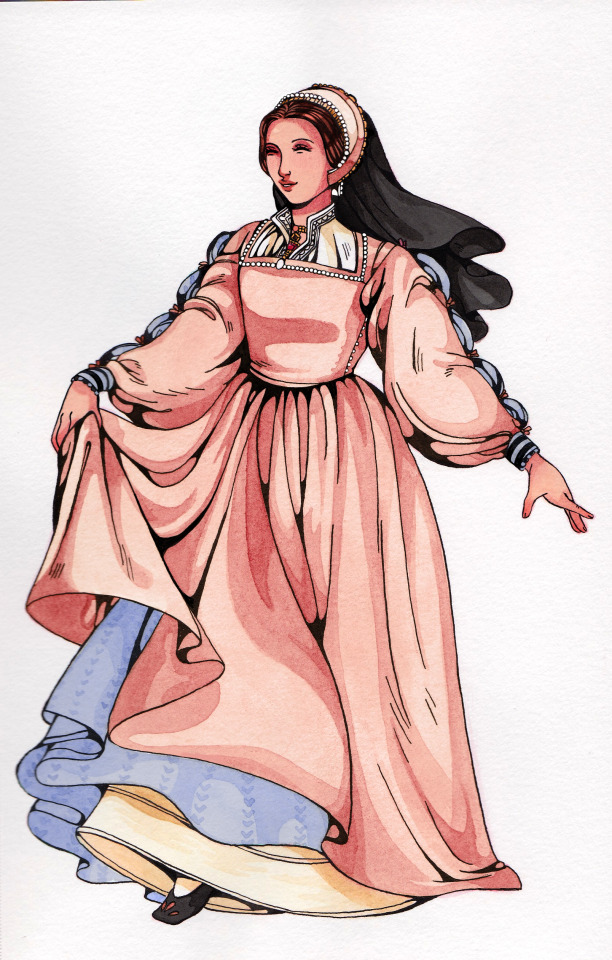
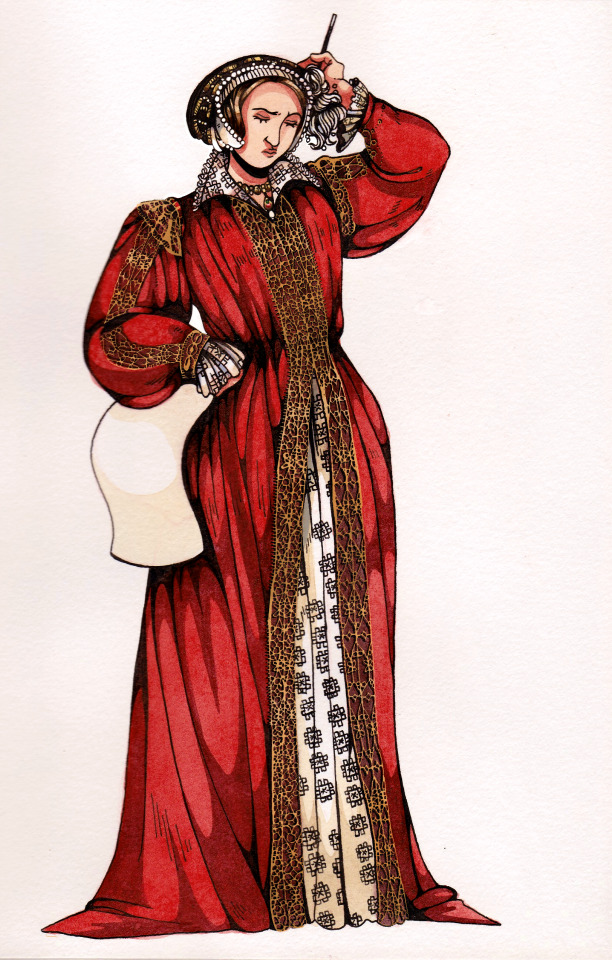
Last two of Henry VIII's wives, two more K/Catherines! I'm all finished with this project!
Katherine Howard was Henry's fifth and youngest wife, and second to die by execcution at her husband's hand. She was cousin to Anne Boleyn, and like her, rose to the king's favor as a lady in waiting to Anne of Cleves. Her age at the time of their marriage being speculated to be between 15 to 21-- her husband was 49. The crimes levied against her at her arrest were primarily to do with two alleged affairs that the king was not aware of at the time of the union. History has not been kind to this young woman. Thankfully there has been recent retreadings of her story, and more scruitiny has been called upon to the older men who claimed to have loved her. She reportedly loved to dance, which is why I painted her mid-step. I also wanted to show off some Tudor era garments, so the lift of her dress is greatly exagerrated.
Katherine Parr was Henry's final wife. At the time of their marriage she had already been widowed twice, and was in service to Mary as a lady in waiting. Katherine was a staunch Protestant, perhaps even more so than Anne Boleyn, as she fervently supported the Reformation, and even spoke to Henry about finishing this work (at this point Henry himself lived as a quasi-Catholic, and was comfortable in the state of limbo he left his realm in by not defining Anglicanism further), which famously almost cost her her head. Katherine is actually quite notable for being the first named female author published in England, and she has three works credited to her. After Henry passed, Katherine made a swift marriage to her one-time lover, Thomas Seymour, which caused a great deal of scandal and pain to her step-children. She died after giving birth to a daughter only about a year after Henry. The dress she is wearing is based on a Tudor portrait by an unknown artist. It seems to be depicting the queen in a more relaxed attire than formal court attire, but, I have to say, I wish I had chosen a different outfit. Since making this design there has been a brilliant discovery of another portrait of Katherine, and if I ever will return to Katherine, I'd like to base her on that one. The portrait I referenced in this picture is dated to the late sixteenth century, but Katherine died in 1548, so I can't help but wonder if the dress is innaccurate. Curiously, there is also speculation that she had originally been painted wearing a French Hood for the piece, which was painted over later-- but it's only a theory.
#art#henry viii#tudors#six wives of henry viii#katherine parr#katherine howard#artists on tumblr#illustration#watercolor#ink#renaissance history
500 notes
·
View notes
Text
Below the cut I have made a list of each English and British monarch, the age of their mothers at their births, and which number pregnancy they were the result of. Particularly before the early modern era, the perception of Queens and childbearing is quite skewed, which prompted me to make this list. I started with William I as the Anglo-Saxon kings didn’t have enough information for this list.
House of Normandy
William I (b. c.1028)
Son of Herleva (b. c.1003)
First pregnancy.
Approx age 25 at birth.
William II (b. c.1057/60)
Son of Matilda of Flanders (b. c.1031)
Third pregnancy at minimum, although exact birth order is unclear.
Approx age 26/29 at birth.
Henry I (b. c.1068)
Son of Matilda of Flanders (b. c.1031)
Fourth pregnancy at minimum, more likely eighth or ninth, although exact birth order is unclear.
Approx age 37 at birth.
Matilda (b. 7 Feb 1102)
Daughter of Matilda of Scotland (b. c.1080)
First pregnancy, possibly second.
Approx age 22 at birth.
Stephen (b. c.1092/6)
Son of Adela of Normandy (b. c.1067)
Fifth pregnancy, although exact birth order is uncertain.
Approx age 25/29 at birth.
Henry II (b. 5 Mar 1133)
Son of Empress Matilda (b. 7 Feb 1102)
First pregnancy.
Age 31 at birth.
Richard I (b. 8 Sep 1157)
Son of Eleanor of Aquitaine (b. c.1122)
Sixth pregnancy.
Approx age 35 at birth.
John (b. 24 Dec 1166)
Son of Eleanor of Aquitaine (b. c.1122)
Tenth pregnancy.
Approx age 44 at birth.
House of Plantagenet
Henry III (b. 1 Oct 1207)
Son of Isabella of Angoulême (b. c.1186/88)
First pregnancy.
Approx age 19/21 at birth.
Edward I (b. 17 Jun 1239)
Son of Eleanor of Provence (b. c.1223)
First pregnancy.
Age approx 16 at birth.
Edward II (b. 25 Apr 1284)
Son of Eleanor of Castile (b. c.1241)
Sixteenth pregnancy.
Approx age 43 at birth.
Edward III (b. 13 Nov 1312)
Son of Isabella of France (b. c.1295)
First pregnancy.
Approx age 17 at birth.
Richard II (b. 6 Jan 1367)
Son of Joan of Kent (b. 29 Sep 1326/7)
Seventh pregnancy.
Approx age 39/40 at birth.
House of Lancaster
Henry IV (b. c.Apr 1367)
Son of Blanche of Lancaster (b. 25 Mar 1342)
Sixth pregnancy.
Approx age 25 at birth.
Henry V (b. 16 Sep 1386)
Son of Mary de Bohun (b. c.1369/70)
First pregnancy.
Approx age 16/17 at birth.
Henry VI (b. 6 Dec 1421)
Son of Catherine of Valois (b. 27 Oct 1401)
First pregnancy.
Age 20 at birth.
House of York
Edward IV (b. 28 Apr 1442)
Son of Cecily Neville (b. 3 May 1415)
Third pregnancy.
Age 26 at birth.
Edward V (b. 2 Nov 1470)
Son of Elizabeth Woodville (b. c.1437)
Sixth pregnancy.
Approx age 33 at birth.
Richard III (b. 2 Oct 1452)
Son of Cecily Neville (b. 3 May 1415)
Eleventh pregnancy.
Age 37 at birth.
House of Tudor
Henry VII (b. 28 Jan 1457)
Son of Margaret Beaufort (b. 31 May 1443)
First pregnancy.
Age 13 at birth.
Henry VIII (b. 28 Jun 1491)
Son of Elizabeth of York (b. 11 Feb 1466)
Third pregnancy.
Age 25 at birth.
Edward VI (b. 12 Oct 1537)
Son of Jane Seymour (b. c.1509)
First pregnancy.
Approx age 28 at birth.
Jane (b. c.1537)
Daughter of Frances Brandon (b. 16 Jul 1517)
Third pregnancy.
Approx age 20 at birth.
Mary I (b. 18 Feb 1516)
Daughter of Catherine of Aragon (b. 16 Dec 1485)
Fifth pregnancy.
Age 30 at birth.
Elizabeth I (b. 7 Sep 1533)
Daughter of Anne Boleyn (b. c.1501/7)
First pregnancy.
Approx age 26/32 at birth.
House of Stuart
James I (b. 19 Jun 1566)
Son of Mary I of Scotland (b. 8 Dec 1542)
First pregnancy.
Age 23 at birth.
Charles I (b. 19 Nov 1600)
Son of Anne of Denmark (b. 12 Dec 1574)
Fifth pregnancy.
Age 25 at birth.
Charles II (b. 29 May 1630)
Son of Henrietta Maria of France (b. 25 Nov 1609)
Second pregnancy.
Age 20 at birth.
James II (14 Oct 1633)
Son of Henrietta Maria of France (b. 25 Nov 1609)
Fourth pregnancy.
Age 23 at birth.
William III (b. 4 Nov 1650)
Son of Mary, Princess Royal (b. 4 Nov 1631)
Second pregnancy.
Age 19 at birth.
Mary II (b. 30 Apr 1662)
Daughter of Anne Hyde (b. 12 Mar 1637)
Second pregnancy.
Age 25 at birth.
Anne (b. 6 Feb 1665)
Daughter of Anne Hyde (b. 12 Mar 1637)
Fourth pregnancy.
Age 27 at birth.
House of Hanover
George I (b. 28 May 1660)
Son of Sophia of the Palatinate (b. 14 Oct 1630)
First pregnancy.
Age 30 at birth.
George II (b. 9 Nov 1683)
Son of Sophia Dorothea of Celle (b. 15 Sep 1666)
First pregnancy.
Age 17 at birth.
George III (b. 4 Jun 1738)
Son of Augusta of Saxe-Gotha (b. 30 Nov 1719)
Second pregnancy.
Age 18 at birth.
George IV (b. 12 Aug 1762)
Son of Charlotte of Mecklenburg-Strelitz (b. 19 May 1744)
First pregnancy.
Age 18 at birth.
William IV (b. 21 Aug 1765)
Son of Charlotte of Mecklenburg-Strelitz (b. 19 May 1744)
Third pregnancy.
Age 21 at birth.
Victoria (b. 24 May 1819)
Daughter of Victoria of Saxe-Coburg-Saafield (b. 17 Aug 1786)
Third pregnancy.
Age 32 at birth.
Edward VII (b. 9 Nov 1841)
Daughter of Victoria of the United Kingdom (b. 24 May 1819)
Second pregnancy.
Age 22 at birth.
House of Windsor
George V (b. 3 Jun 1865)
Son of Alexandra of Denmark (b. 1 Dec 1844)
Second pregnancy.
Age 20 at birth.
Edward VIII (b. 23 Jun 1894)
Son of Mary of Teck (b. 26 May 1867)
First pregnancy.
Age 27 at birth.
George VI (b. 14 Dec 1895)
Son of Mary of Teck (b. 26 May 1867)
Second pregnancy.
Age 28 at birth.
Elizabeth II (b. 21 Apr 1926)
Daughter of Elizabeth Bowes-Lyon (b. 4 Aug 1900)
First pregnancy.
Age 25 at birth.
Charles III (b. 14 Nov 1948)
Son of Elizabeth II of the United Kingdom (b. 21 Apr 1926)
First pregnancy.
Age 22 at birth.
378 notes
·
View notes
Text
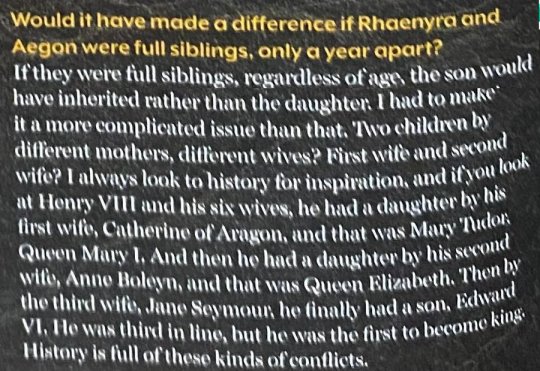
[Would it have made a difference if Rhaenyra and Aegon were full siblings, only a year apart? If they were full siblings, regardless of age, the son have inherited rather than the daughter. I had to make it more complicated than that. Two children by different mothers, different wives? First wife and second wife? I always look to history for inspiration, and if you look at Henry VIII and his six wives, he had a daughter by his first wife, Catherine of Aragon, and that was Mary Tudor, Queen Mary I. And then he had a daughter by his second wife, Anne Boleyn, and that was Queen Elizabeth. Then by the third wife, Jane Seymour, he finally had a son, Edward VI. He was third in line, but he was the first to become king. History is full of these kinds of conflicts.]
I needed to read this twice.

Edward wasn't third in line!!!!!!!!! He was the youngest of Henry's three surviving children, but since England followed male preference primogeniture until very recently, he was FIRST in line after his father died and if he had sired a child before his death, that child would have been his successor. The potential problem with the succession was that if Henry's marriage to Catherine was valid, then Elizabeth was illegitimate, but if their marriage was invalid then Mary was illegitimate.
As @duxbelisarius pointed out if Martin really wanted a Matilda/Stephen analogy Rhaenys and Viserys are right there. But that would require painting his beloved Daemon in a negative light.
124 notes
·
View notes
Text
Long Post Incoming
——————
I don’t know who needs to hear this (*cough* TB stans *cough*) but Aegon has always had a stronger claim that Rha*nyra.
According to Andal law, a son comes before a daughter, and a niece comes before an uncle. The only time Rha*nyra had a strong claim was when she was Vis*rys’s only living child. No one wanted Da*mon on the IT because they knew that he would essentially be a second Maegor (or worse). Not only was Rha*nyra more well liked at the time, but in accordance to the law, she had a stronger claim that Da*mon.
At the end of the day, Rha*nyra being named heir had nothing to do with Rha*nyra. In the book, she was named heir so that Da*mon wouldn’t become king, and in the show, she was named heir because of Vis*rys’s guilt for killing Aemma. It was never about her. But, once Rha*nyra heard her daddy name her his successor, she rolled with it and refused to give up her claim. Which again, at the time, was at its strongest.
That is, until Vis*rys married Alicent and had Aegon.
Otto states that the succession changed the second Aegon was born, and although Otto isn’t the easiest man to like, he wasn’t wrong. As soon as Vis*rys fathered a living son, Rha*nyra was brought down from being first in line, to being second in line, with Da*mon now being third in line.
Now GRRM harkened back to Henry VIII and the succession crisis regarding his three living children (Mary, Elizabeth, and Edward), and states that Edward was third in line but was to become king first.
There’s just one problem. There was no succession crisis.
Edward, despite his age, was ALWAYS first in line for the throne. Everyone and their mother knew the second he was born, he would be Henry’s heir. Henry removed Mary and Elizabeth from the succession and denounced them as illegitimate because he annulled his marriages to his first and second wives, Catherine of Aragon and Anne Boleyn.
Mary and Elizabeth were only returned to the succession through the Third Succession Act of 1543 because Henry did not father anymore sons, and he needed spares should anything happen to Edward. But Edward remained first in line nonetheless, whereas Mary and Elizabeth followed right after despite both of them being older.
Because of Aegon’s birth, Rha*nyra’s claim has weakened substantially, and while it’s still stronger than Da*mon’s, people will naturally gravitate towards Aegon due to the majority of Westeros, save for Dorne, following male primogeniture.
If Vis*ys really wanted to strengthen his daughters claim and instill her as heir, then he would’ve never remarried and had sons. He would’ve helped Rha*nyra gain allies, and teach her how to rule. But he didn’t. He just named her heir and that’s it.
Which is why Vis*rys still wanting Rha*nyra to be his successor despite having Aegon is stupid, because the law dictates that Aegon is first in line. And Vis*rys never changed the laws of succession, he only wanted his daughter to be the exception.
Now if this were Dorne, where absolute primogeniture is practiced, then Rha*nyra would most certainly be the uncontested heir. But since she’s not Dornish, Rha*nyra’s claim to the IT is weaker than Aegon’s. And it only gets weaker once Vis*rys sires two more sons following Aegon.
With the births of Aegon, Aemond, and Daeron, Rha*nyra is pushed even further down the line of succession. And when Aegon has two legitimate sons of his own (Jaehaerys and Maelor), she’s pushed even further down the line.
It’s why Da*mon groomed and married her: so he would get closer to the throne. But even with their claims combined, and despite the fact that they have Aegon III and Viserys II, Aegon’s claim is still strong.
Correct me if I’m wrong, but this is what the succession should look like:
Aegon II—>Jaehaerys—>Maelor—>Aemond—>Daeron—>Rha*nyra—>Aegon III—>Viserys II—>Helaena—>Jaehaera—>Da*mon
Fans can scream about how Rha*nyra and the Blacks had more houses supporting them during the Dance (which realistically doesn’t make a lick of sense), but it doesn’t change the fact that Aegon has always had the stronger claim.
You can say that she was usurped all you want, but it doesn’t mean that Aegon didn’t have a claim to the throne. If anything, he had the strongest claim of them all.
And not only that, but Aegon had legitimate sons as his heirs, unlike Rha*nyra, who was trying to pass off her illegitimate bastard sons as her heirs, despite it being very illegal.
People say that Jace, Luke, and Joff were fighting for their claims when… they literally had no claims to begin with. They’re illegitimate bastards who shouldn’t be anywhere near the line of succession. Just because they have the last name Velaryon and Laenor “accepted” them, doesn’t suddenly make them legitimate.
That’s like that saying that because Joffrey, Myrcella, and Tommen had the last name Baratheon, it suddenly means they were Robert’s trueborn children, when we know they weren’t.
All in all, Vis*rys was the real reason for the Dance happening, all because he couldn’t make up his mind about the succession and was politically inept. And no, him marrying Laena wouldn’t have stopped the Dance from happening because there still would’ve been a chance that Laena birthed a son (or sons).
#house of the dragon#game of thrones#pro team green#anti team black#anti viserys i targaryen#anti rhaenyra targaryen#anti daemon targaryen#neither aegon nor nyra deserved the throne#but you cant say that aegon didnt have a claim#cause yes tf he did
76 notes
·
View notes
Photo

Edward VI of England
Edward VI of England reigned as king from 1547 to 1553 CE. Succeeding his father Henry VIII of England (r. 1509-1547 CE), Edward was only nine years old at the time and so the kingdom was ruled by a council of nobles, foremost among whom was Edward's maternal uncle, Edward Seymour (l. c. 1500-1552 CE) until he was replaced by John Dudley, the Earl of Northumberland (l. 1504-1553 CE). During Edward's reign, Protestant religious reforms continued as the Church of England broke further away from the traditions of the established Catholic Church directed by the Pope. There were also popular uprisings as the economy faltered and inflation was rampant. Edward's reign was short as he died of tuberculosis aged just 15. He was succeeded by his cousin Lady Jane Grey (1537-1554 CE) until what the majority of the people and nobility regarded as the rightful heir, his elder half-sister, was installed nine days later as Mary I of England (r. 1553-1558 CE).
Henry VIII & The Succession
Henry VIII married six times but it was his first three marriages that each produced a future monarch. With Catherine of Aragon (1485-1536 CE), Henry had a daughter, Mary (b. Feb. 1516 CE). With Anne Boleyn (c. 1501-1536 CE), there was another daughter, Elizabeth (b. Sep. 1533 CE). With wife number three, Jane Seymour, who was a lady-in-waiting at court, Henry had his first and last legitimate son, Edward, born on 12 October 1537 CE in Hampton Court Palace. At the joyous news, there followed 2,000 cannon shots let off in the Tower of London, bells rang out across England and there were 24 hours of parties and feasts but, tragically, Jane died 12 days after giving birth, most likely from post-natal fever.
As the first marriage was annulled to permit the second and Anne Boleyn was executed on charges of adultery, so each of their children was disinherited and it was Edward who became the official heir to the throne. As more wives came and went and no more children were forthcoming, Henry changed his mind in 1544 CE and declared that Edward could be succeeded by his half-sister Mary with Elizabeth next in line.
Henry VIII's health declined rapidly in his later years as the king became seriously overweight and suffered a badly ulcerated leg. The king died on 28 January 1547 CE at Whitehall Palace in London; he was 55 years old. Henry was buried in Saint George's Chapel at Windsor Castle, next to his late third wife, Jane Seymour, and he was duly succeeded by Edward who became Edward VI at his coronation in Westminster Abbey on 20 February 1547 CE. Henry, having split the Church in England from Rome to acquire his first marriage annulment and gone on a massive spending spree on palaces and wars, left his son an impoverished kingdom split over religious issues and, particularly, whether or not to press on with reforming the Church.
Continue reading...
24 notes
·
View notes
Note
I read through all your posts about Alysanne Targaryen as Maegor's daughter and am now in a rabbit hole. Thank you. I've been thinking about Maegor's wives and which one of Henry VIII's wives they represent. Ceryse is Cathrine of Aragon and Alys is Anne Boleyn. The others are hard to pin for me since there isn't a lot. What do you think? Would Maegor's reign have been more interesting if his marriages had more similarities to those of Henry VIII?
I think this is where we run into a number of problems regarding the way GRRM wrote Fire & Blood specifically and the way he setup Westeros more generally.
For one, the fairly homogenized nature of southron culture as well as the oversimplification of religious institutions and history means you can't quite get the same dynamism as from real life European history, with its dizzying array of languages, cultures, cuisines, fashions, etc., to mention nothing of the then-ongoing Protestant Reformation. I suppose GRRM could have had Maegor convert to the Old Gods a la Julian (II) the Apostate or the Drowned God (you just know the Ironborn are the one race on the surface of Planetos that would say King Maegor the Good with a completely straight face) or even R'hllor, which would be the best choice in terms of worldbuilding opportunities in my opinion.
Moving on, we run into a handful of problems with Maegor specifically, one of them being the length of his reign. Look, while I can't deny Maegor ruling for 6 years and 66 days is incredibly cheeky, it also isn't anywhere close to Henry VIII's 36 years as king. With so little room timeline-wise, there isn't a lot of flexibility when it comes to telling new stories and fleshing out preexisting ones and all that is before you factor in Maegor himself.
I won't hold back. For all GRRM's talk of moral ambiguity, the human heart in conflict with itself, good men who were bad kings and bad men who were good kings, etc., his Targaryen monarchs are, for the most part, numbingly one-note. Aegon I is a literal enigma, Aenys is weak, Maegor cruel, Viserys I a party animal, Aegon II and Rhaenyra mirror-images of each other in their disqualifying vices, etc. As I've written before with my post reimagining Maegor as more of a Ivan (IV) the Terrible figure there was room to make him a genuinely controversial figure of historiography but instead GRRM doubled down on sensationalism and apathy-inducing slasher porn for lack of a better word. The fact Maegor is also the first and last of Visenya's line just adds more salt to the wound but that's part of GRRM's more general (and for me personally, vexing) habit of keeping family trees incredibly small.
(I do recall another alternative someone once brought up to the late Steven Attewell. Namely, turning Maegor into the Westerosi version of Macbeth by way of Der Untergang.)
This brings me to my semifinal point. GRRM didn't have to write Fire & Blood as Procopius' Secret History on steroids with a dash of Suetonius' Lives of Twelve Caesars and I, Claudius (the entire Saera episode is practically lifted wholesale from the scandal that envelops Augustus' daughter, Julia) but he did, which is doubly disappointing because not only does the final product suck quality-wise as a result but also because there were so many other avenues available to him.
He could have written Fire & Blood as a proper history (with less focus on the sex lives of teenage girls for one) or as a mirror for princes or as a dialogue between two characters or even as a character study. You can even see GRRM struggling with the constraints imposed by his use of Gyldayn in certain sections like the death of Maelor and the entire Hour of the Wolf episode, where you get reams of dialogue and characterization as well as more traditional narrative trappings like build-up, mood setting, etc.
Now, to answer your actual question (lol), I don't think any of Henry VIII's other wives map well onto Maegor's. Tyanna is, more or less, his female counterpart in terms of cruelty and zero redeeming features and entirely a fantasy construct. Elinor and Jeyne are both married to Maegor for only a year (with poor Jeyne dying in childbirth because Jeyne Westerlings, like the Brackens, Peakes, and Florents, cannot catch a break in Westeros) and before said marriage takes place neither appears on the page. As for Rhaena, well, credit where its due, she was a rare (and unexpected) highlight of Fire & Blood.
Thanks for the question, anon
#maegor the cruel#house targaryen#asoiaf criticism#asoiaf meta#valyrianscrolls#asoiaf#asoiaf themes#maegor targaryen#fire and blood#volume 1
43 notes
·
View notes
Text
Royal Reads: Jan-Mar 2024
Note: Some of the following links are affiliate links, which means I earn a commission on every purchase. This does not affect the price you pay.
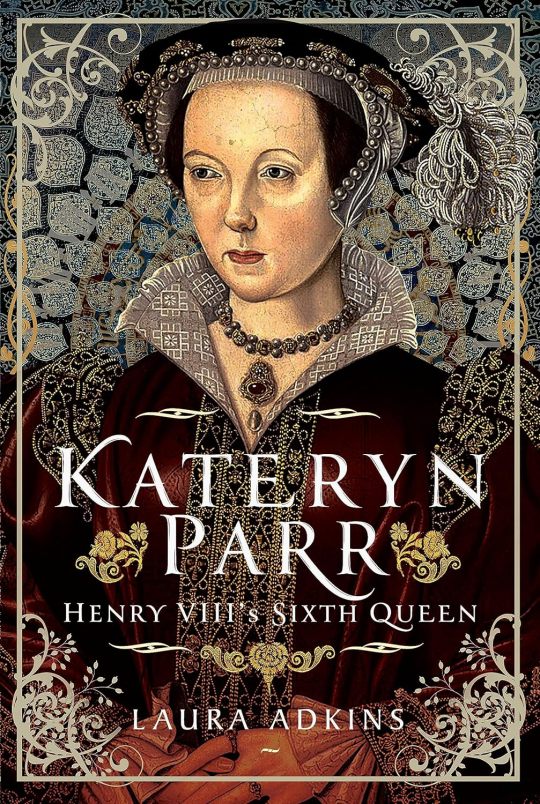

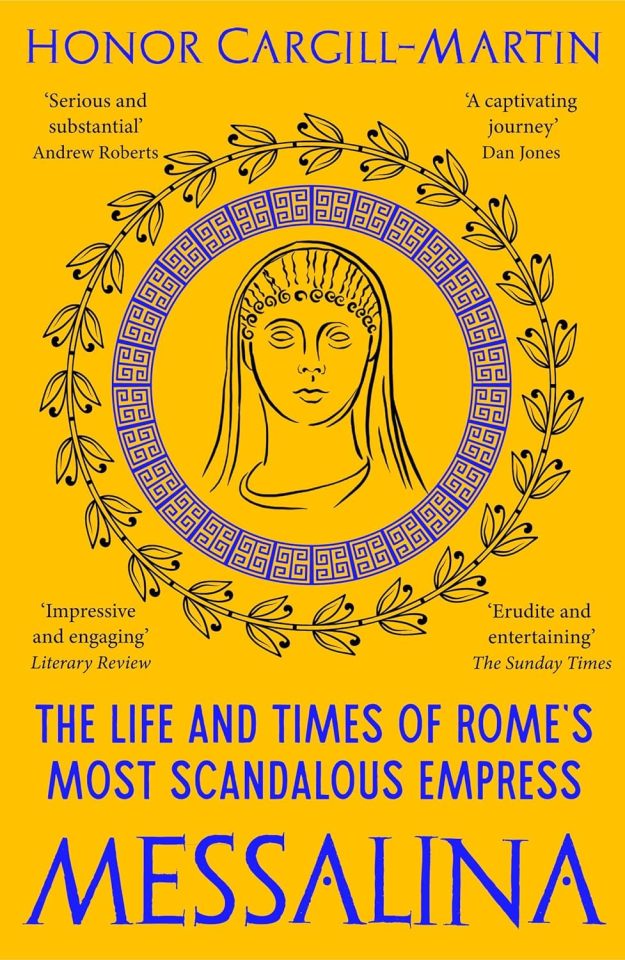
Kateryn Parr: Henry VIII's Sixth Queen by Laura Adkins (Mar. 15, 2024) // Anne Boleyn & Elizabeth I: The Mother and Daughter Who Changed History by Tracy Borman (new paperback version published Mar. 7, 2024) // Messalina: The Life and Times of Rome’s Most Scandalous Empress by Honor Cargill-Martin (Mar. 14, 2024)
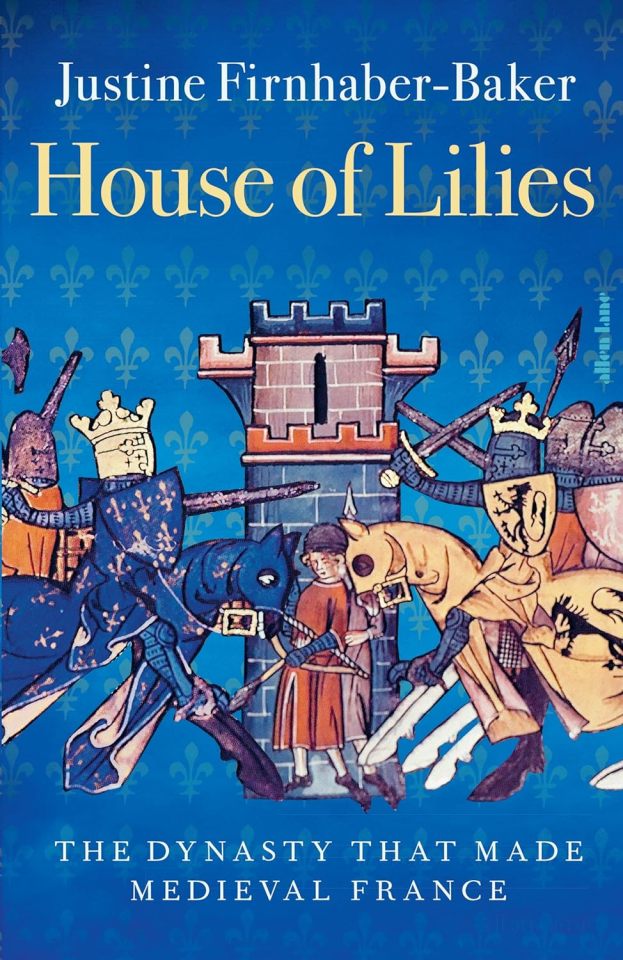
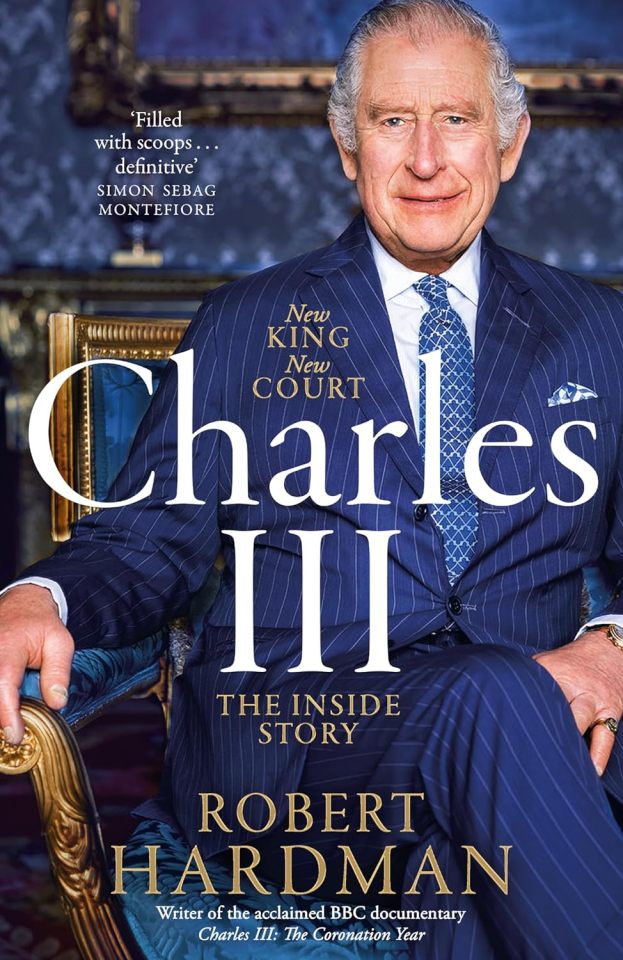
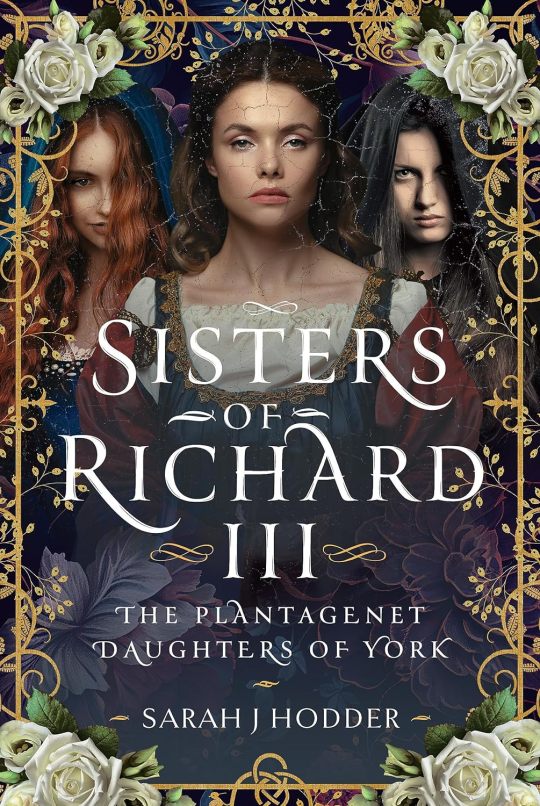
House of Lilies: The Dynasty that Made Medieval France by Justine Firnhaber-Baker (Mar. 28, 2024) // Charles III: New King. New Court. The Inside Story. by Robert Hardman (Jan. 18, 2024) // Sisters of Richard III: The Plantagenet Daughters of York by Sarah J Hodder (Mar. 15, 2024)
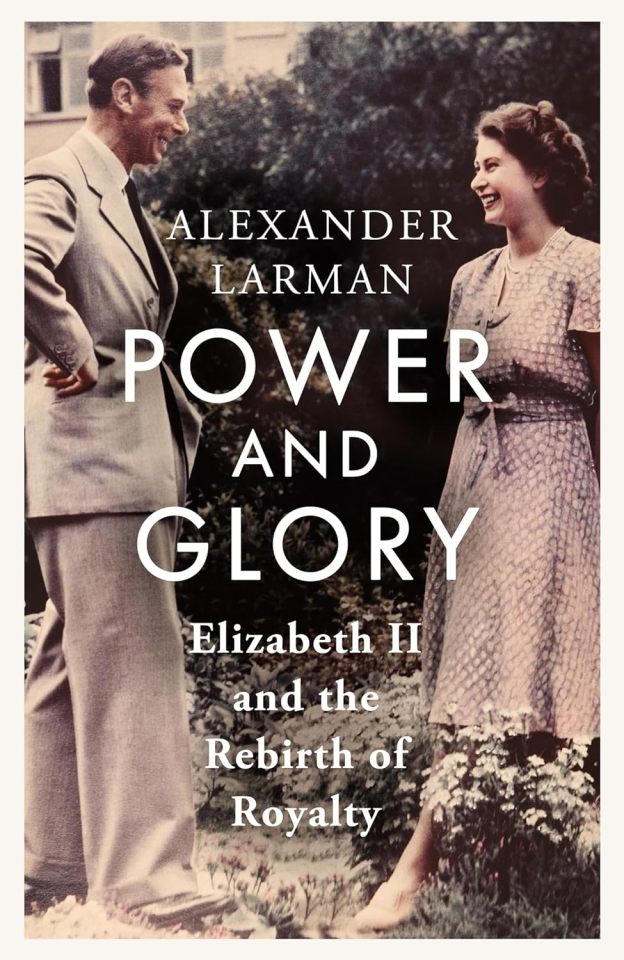
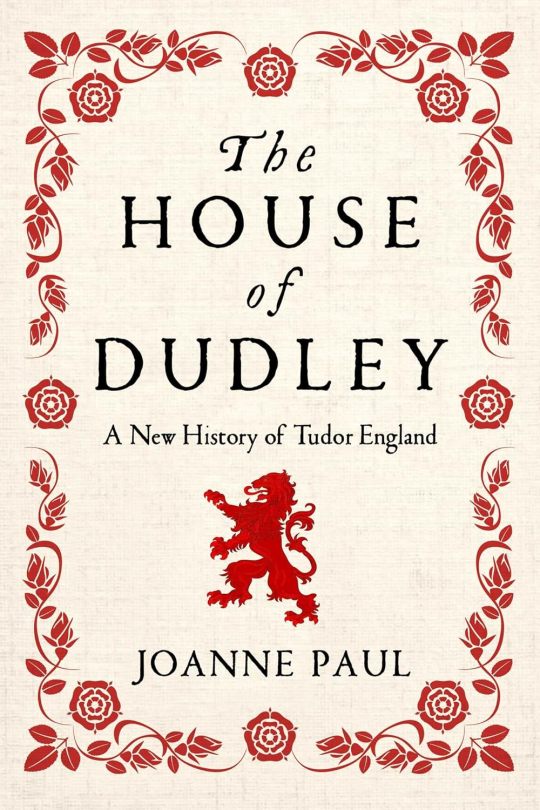
Power and Glory: Elizabeth II and the Rebirth of Royalty by Alexander Larman (Mar. 28, 2024) // The House of Dudley: A New History of Tudor England by Joanne Paul (new paperback version published Jan. 9, 2024)
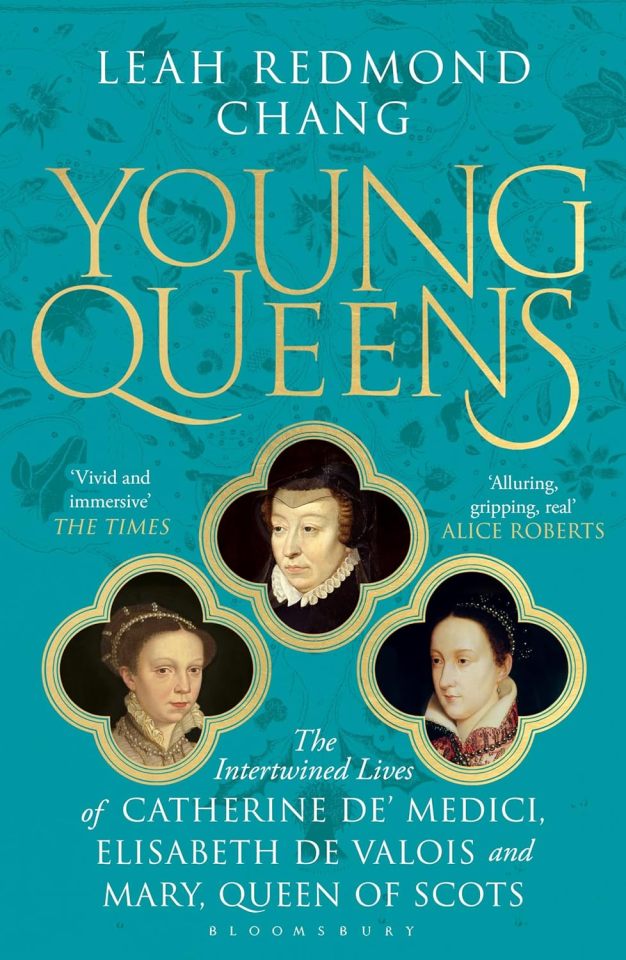
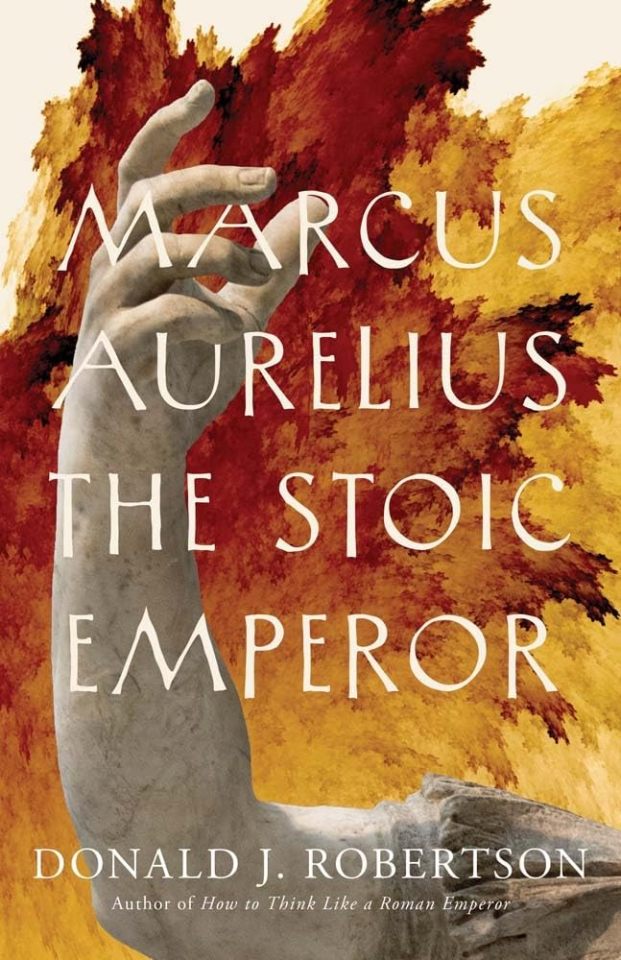
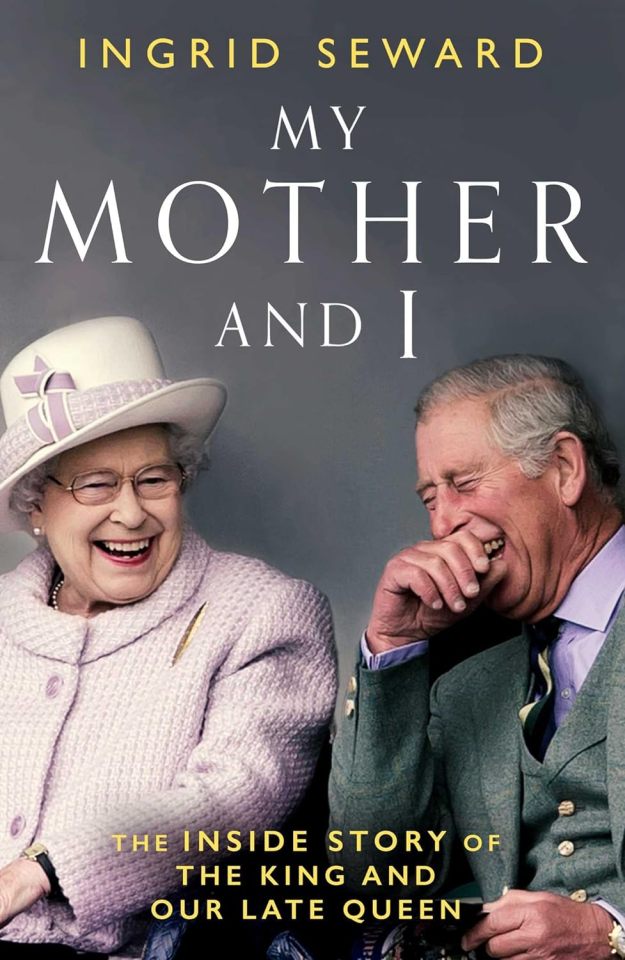
Young Queens: The Intertwined Lives of Catherine De' Medici, Elisabeth de Valois, and Mary, Queen of Scots by Leah Redmond Chang (new paperback version published Feb. 29, 2024) // Marcus Aurelius: The Stoic Emperor by Donald J. Robertson (Mar. 26, 2024) // My Mother and I by Ingrid Seward (Feb. 15, 2024)
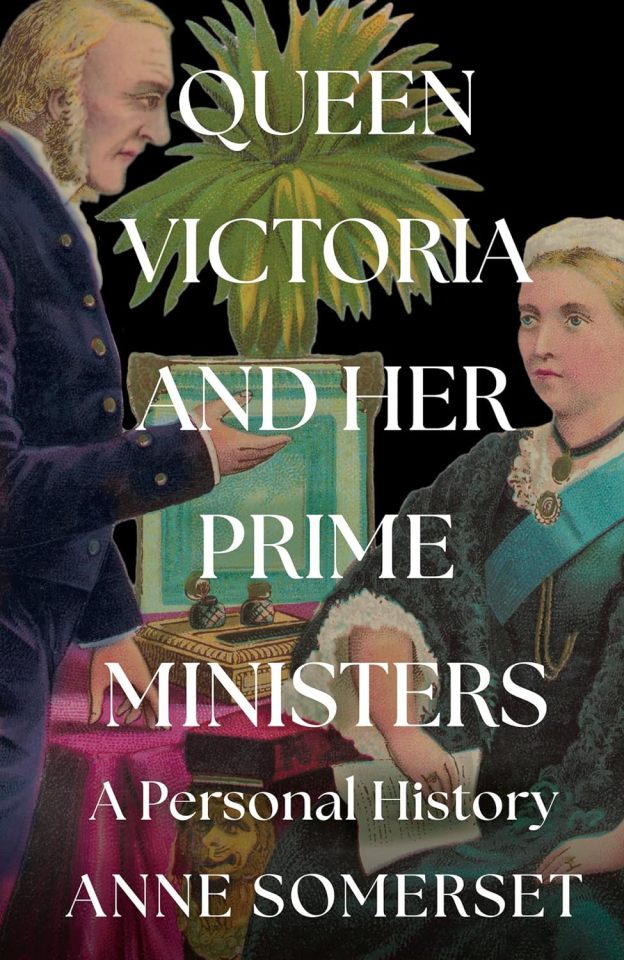
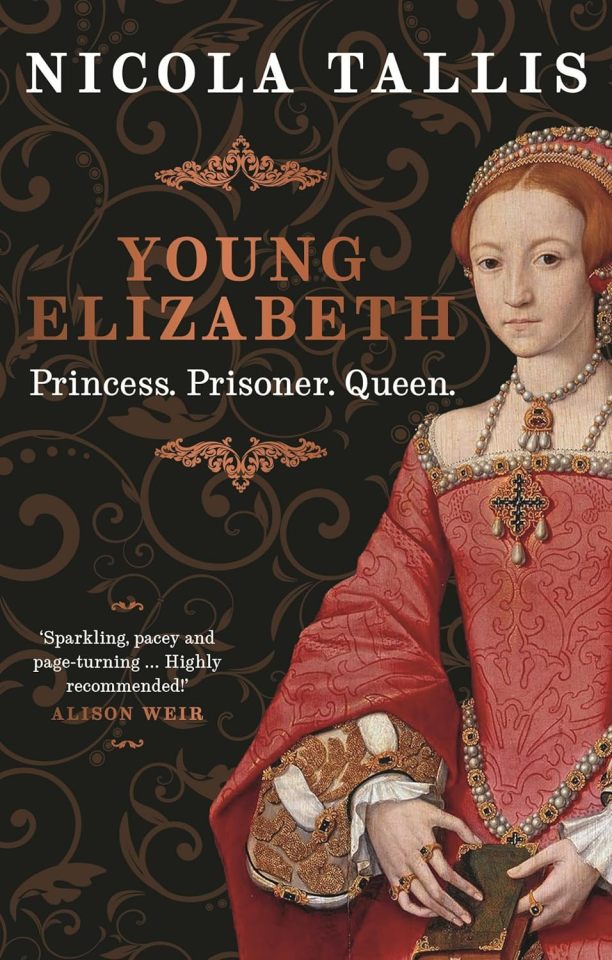
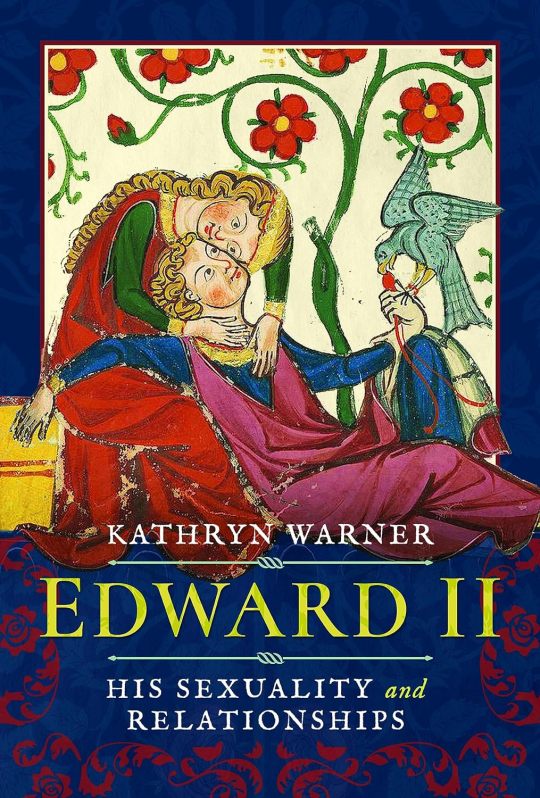
Queen Victoria and her Prime Ministers: A Personal History by Anne Somerset (Mar. 28, 2024) // Young Elizabeth: Princess. Prisoner. Queen. by Nicola Tallis (Feb. 29, 2024) // Edward II: His Sexuality and Relationships by Kathryn Warner (Mar. 15, 2024)
#literature#affiliate links#catherine parr#anne boleyn#elizabeth i#valeria messalina#king charles iii#anne of york#elizabeth of york#margaret of york#queen elizabeth ii#catherine de medici#isabel de valois#mary queen of scots#marcus aurelius#queen victoria#edward ii
31 notes
·
View notes
Text
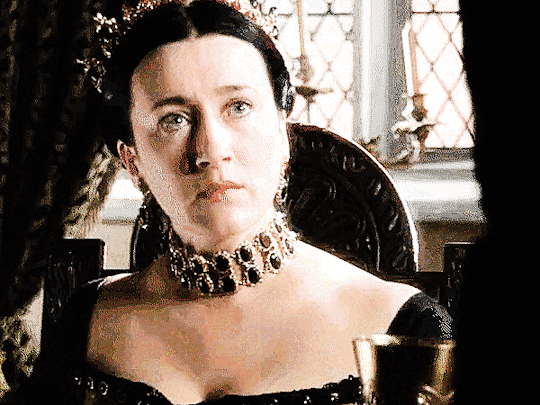
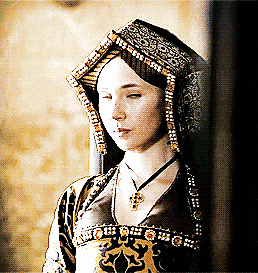
Katherine of Aragon & Gertrude Courtenay
Gertrude was daughter of William Blount, fourth Baron Mountjoy, a distinguished humanist scholar and chamberlain to Katherine of Aragon. As the daughter of such an esteemed gentleman at court, Gertrude received an outstanding education and served Katherine of Aragon as one of her maids of honor. The Queen oversaw the education of her young charges, so Gertrude benefitted from the royal patronage. In 1519, she married to Henry VIII’s first cousin Henry Courtenay, Earl of Devon. Gertrude was the wife and mother of the last Plantagenets at the Tudor court.
Gertrude was one of Queen Katherine of Aragon's attendants at the Field of the Cloth of Gold in 1520. If the Chateau Vert rings any bells it’s probably because it was the masque that saw Anne Boleyn, freshly returned from France, debuting at the Tudor court in March 1522. A little-known fact is that Gertrude Courtenay also took part in it, playing the role of Honour. In 1525, Gertrude’s star was on the rise once again when her husband was created the Marquess of Exeter, making Gertrude a Marchioness.

Gertrude was among the key political players of Henry VIII’s court during the infamous annulment, known as the Great Matter, commencing in 1527 and ending in 1536. The Marchioness of Exeter was among the high-profile ladies-in-waiting who staunchly supported Katherine of Aragon. Seeing how popular the Queen was among the women at court, Anne Boleyn used her influence and dismissed some of them, including Gertrude.
During the summer of 1531, Katherine of Aragon was banished from court. The Queen received gifts and letters from her trusted friends and former servants like Gertrude Courtenay in her exile.

Henry VIII had had enough of his wife’s resistance, and he married the pregnant Anne Boleyn in secret on 25 January 1533. On 31 May, Anne rode in a procession from the Tower of London to Westminster Hall—it was the most impressive part of the coronation festivities. The Marchioness of Exeter opened the cavalcade, a clear sign that she was a high-profile lady-in-waiting. Gertrude had no other choice but to follow the King’s orders and accompany the new Queen: a clear sign to Katherine’s followers that unconditional obedience was required. Gertrude’s husband managed to avoid appearing at Anne’s coronation. Whether the illness Henry Courtenay suffered in June was real or feigned cannot be discerned now, but Gertrude later “much lamented her husband’s sickness at the time of the Queen’s coronation, and said that though her person was there, her heart was at home with her husband”.
Gertrude’s prominent role during the christening of Anne Boleyn’s daughter was calculated as an insult to Katherine of Aragon. Henry VIII selected Gertrude as one of Princess Elizabeth’s godmothers. The disgusted Marchioness complained to her friends that “she really wanted to have nothing to do with this” but took part “so as not to displease the King”.
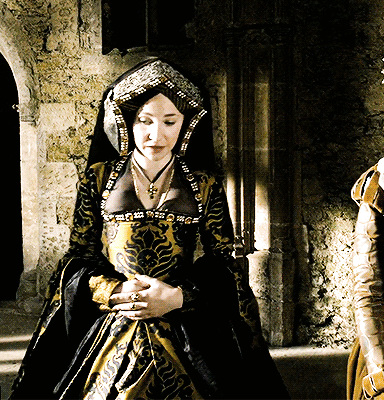
Like her father, Gertrude walked on eggshells trying not to displease the King, but ultimately it was impossible for her to accept Anne Boleyn as the new Queen. The Catholic Marchioness soon found herself in a position of open defiance of Henry VIII and his second wife. Gertrude gave ear to the Nun of Kent’s prophecies (for which the Nun was executed in 1534). She remained fiercely loyal to Katherine of Aragon and Princess Mary in their fell from grace. She exchanged letters with Eustace Chapuys, ambassador of the Holy Roman Emperor Charles V, and even visited him in disguise during the period when it was dangerous to become Henry VIII’s enemy. How much Gertrude knew of the proposed match between Reginald Pole and Princess Mary remains unknown, but she certainly favoured the idea of the Anglo-Imperial war. In late 1535, Katherine of Aragon’s health began to deteriorate and it became clear to everyone that she was mortally ill. She died on 7 January 1536 amid rumours of poisoning.
Sources:
Sylvia Barbara Soberton, The Forgotten Tudor Women: Gertrude Courtenay. Wife and Mother of the last Plantagenets
https://tudorsdynasty.com/ten-things-you-didnt-know-about-gertrude-courtenay-marchioness-of-exeter/?amp=
#catherine of aragon#katherine of aragon#catalina de aragon#henry viii#gertrude blount#gertrude courtenay#anne boleyn
25 notes
·
View notes
Text
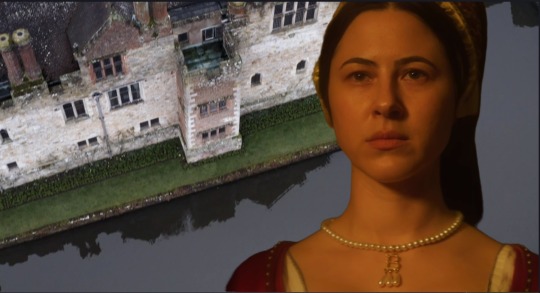
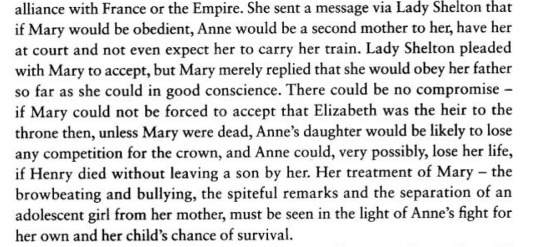

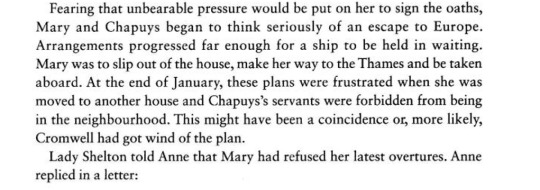
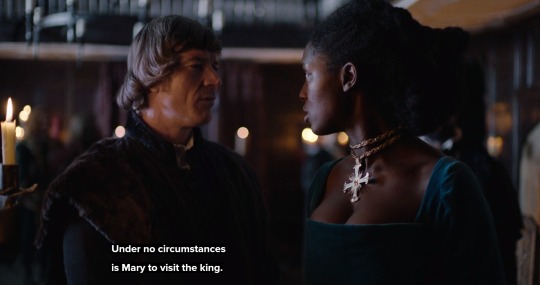
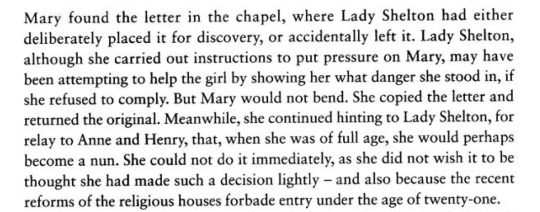
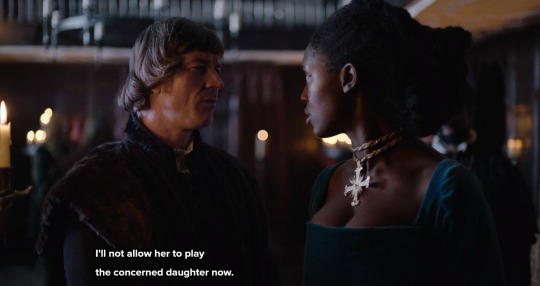
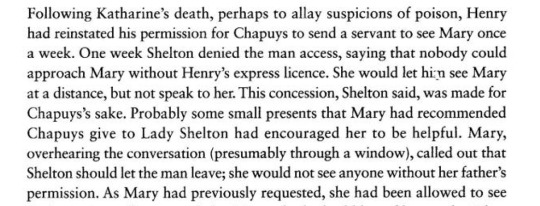
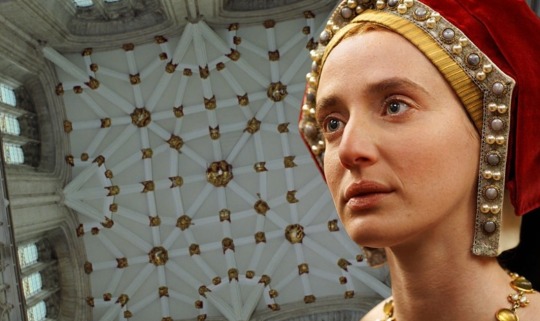
the downfall and execution of a tudor queen (2023) / the boleyns: a scandalous family (2021) / the king's pearl: henry viii and his daughter mary (2017), melita thomas / anne boleyn (tv miniseries 2021) / the mirror and the light (2024) / elizabeth (1998)
#web weaving#sort of?#i never feel like my edits really fit#they're more like collages#anyway...me on my island with the one other tudor fan that liked AB 2021 lol#'our expectations were low but holy fuck' sounds like a lot of consternation about a pretty...solid script?#what i loved most about it was moments like the above#the ability to summarize really complex dynamics borne of circumstance#in such a way that you can believe in the world and it serves as its own 'previously on' that a miniseries inherently lacks#esp when it only covers five crucial months#tl; dr there's a lot of smugness evident in many books of this genre#when it comes to anne's attitude towards her stepdaughter#bcus she was quote proven wrong unquote; becaues mary got quote the last laugh unquote...#when really. as per the quotes i've been posting#it doesn't seem like mary's reconciliation with her father was the idyll many have made it#thus we have anne's letter#and offer. knowing that others are offering her better futures#but saying this is the best future you could have. limited time only.#and it seems the future proved her right; not wrong (at least the immediate future)#bcs while matters; had she accepted; might not've been substantially better than they were under the auspices of a 'more gentle' stepmother#it also doesn't really seem like they would have been substantially worse#anne was right that her enemy's supporters wanted her disgraced and/or dead. she was right in that they wanted elizabeth disgraced#and/or dead. she couldn't have predicted what happened to herself in the exact matter it did- mainly bcus it was unprecedented#but it seems she had a pretty clear view of what mary was doing: playing both sides. attempting to ingratiate herself to her father while#also conspiring against him. and she knew it would have been better to have her on side#(and in a more jaundiced view: have her where she could watch what she was doing; who she was seeing)#but perhaps underestimated how impossible it would be to get her there in the first place#('on side' ; that is. not at court. although probably not that either. with the conditions she demanded)#but her fears of mary were not paranoia. they seem to have been grounded in realism#and a clear view of the situation at home and abroad
22 notes
·
View notes
Note
🦆




George Boleyn-Tudor-Cromwell. Duke of York. Prince of England. Second son, third child. Spy, courtier, wife guy, poet. Did get Shakespeare to write sonnets about how gorgeous and amazing he is.
There’s a (I think) K.A. Applegate quote about ruthlessness being a bright clear line from point A to point B and WOW IS THAT GEORGE. He’s the ruthless political player hiding behind a charming prince/courtier who is known in court for his artistic/intellectual patronage. He does not trust people outside his family - like outside of them people do not know George - though he is so charming no one really gets that. He’s the cynic to his brother the heir who is not (“My brother Thomas is a good man. He doesn’t hold a grudge. That’s what I’m here for” to paraphrase Josh Lyman) and honestly the person behind the charming mask is Fucking Scary. Part of George’s thing is that honestly the only reason there are things he won’t do to protect those he loves is that Tommy would be sad about it. And even then if Tommy doesn’t know…
Also his dad Henry will fight you if you ever say he’s not Henry’s son like NO THAT IS MY CHILD MY PRINCE MY WONDERFUL CHRISTMAS GIFT THE IMAGE OF MY BELOVED SPOUSES (he is biologically not Henry’s, but Anne and Thomas Cromwells (James Frain Cromwell)).
Marries another OC (Madeleine the second daughter of Marguerite of Navarre in this AU) who isn’t so much a morality chain as holding his flower like ‘you are doing amazing sweetie’
George does go through a period of worrying about like, being legitimately a prince but he absolutely got over it because he got Loved So Hard (like one thing about King Henry VIII in this is wow he will fight anyone about this question those are his babies) and also fundamentally he’s pretty grounded in himself.
send me an emoji and I’ll tell you about one of my OCs
11 notes
·
View notes
Text
You know what I just realized?
The Boleyn family is definitely the inspiration behind the Hightowers.
It’s all pretty familiar.
Hightower pimping his daughter to the King for power and privilege (Thomas Boleyn with his daughter, Anne).
Queen Aemma gives her husband a daughter and all her other children die (Katherine of Aragon gives Henry VIII only a daughter, Mary).
Tension between Henry’s first born, Mary, and her stepmother, Anne (Rhaenyra - Alicent tension).
And if Anne Boleyn had given Henry a son (like Alicent gave Viserys), she would have secured her position as Queen and there would have been a civil war between Mary (Henry VIII’s first born child with his first wife) and Anne Boleyn’s son (aka : their own “Dance of Dragons” except without the dragons).

The only difference is that I definitely have more sympathy for Anne Boleyn than I could ever have for Alicent Hightower. As for Alicent, I have already gone into all the things she did. No need to rehash.
Anne Boleyn really was innocent of all the crimes she was accused of, and Henry VIII was an absolute monster (the equivalent of Maegor). Not to mention that the person responsible for all the mess, Anne’s own father (equivalent of Otto Hightower) is the only one who doesn’t end up getting killed. He loses his titles, sure, but he lives out the rest of his life in peace, the bastard, and his children pay the price for his ambitions.
At least GRRM corrected this historic injustice and punishes the Hightowers accordingly, by ending the usurper’s line.
#house of the dragon#anti greens#anti alicent hightower#anti otto hightower#team black#queen rhaenyra#pro team black#anti team green#rhaenyra targaryen#hotd#daemon targaryen#young rhaenyra#pro rhaenyra#princess rhaenyra#black queen#anti aegon ii targaryen#anti green stans#anti alicent stans#anti aemond stans#anti aemond targaryen#hotd rhaenyra#house of the dragon season 2#anti house hightower#anti criston cole#pro daemon targaryen#prince daemon targaryen
63 notes
·
View notes